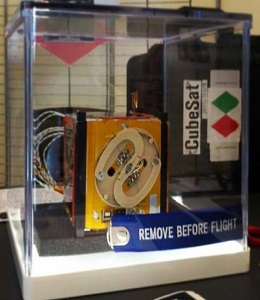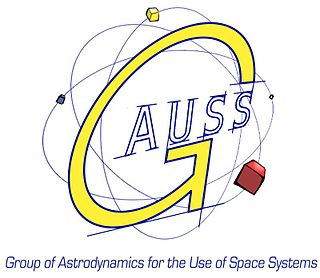
A CubeSat is a class of miniaturized satellite based around a form factor consisting of 10 cm (3.9 in) cubes. CubeSats have a mass of no more than 2 kg (4.4 lb) per unit, and often use commercial off-the-shelf (COTS) components for their electronics and structure. CubeSats are put into orbit by deployers on the International Space Station, or launched as secondary payloads on a launch vehicle. As of August 2021, more than 1,600 CubeSats have been launched.

A small satellite, miniaturized satellite, or smallsat is a satellite of low mass and size, usually under 1,200 kg (2,600 lb). While all such satellites can be referred to as "small", different classifications are used to categorize them based on mass. Satellites can be built small to reduce the large economic cost of launch vehicles and the costs associated with construction. Miniature satellites, especially in large numbers, may be more useful than fewer, larger ones for some purposes – for example, gathering of scientific data and radio relay. Technical challenges in the construction of small satellites may include the lack of sufficient power storage or of room for a propulsion system.
AeroCube-3 is a single-unit CubeSat which was built and is being operated by The Aerospace Corporation, at El Segundo, California. It is the third AeroCube picosatellite, following on from AeroCube-1, which was lost in a launch failure in 2006, and AeroCube-2 which was successfully launched in 2007 but failed immediately after launch. Compared to its predecessors it contains several improvements in its infrastructure, including a redesigned power system, replacing the older system which was responsible for the loss of AeroCube-2. Its development was funded by the United States Air Force Space and Missile Systems Center, at Los Angeles Air Force Base.
HawkSat-1 was a single-unit CubeSat which was built and is being operated by the Hawk Institute for Space Sciences (HISS), Pocomoke City, Maryland. It is based on a Pumpkin Inc. CubeSat kit, and carries a technology demonstration payload, primarily as a proof of concept mission, testing command, data and power subsystems, as well as solar panels and communications.

SARAL is a cooperative altimetry technology mission of Indian Space Research Organisation (ISRO) and Centre National d'Études Spatiales (CNES). SARAL performs altimetric measurements designed to study ocean circulation and sea surface elevation.

NanoSail-D2 was a small satellite built by NASA's Marshall Space Flight Center and Ames Research Center to study the deployment of a solar sail in space. It was a three-unit CubeSat, measuring 30 cm × 10 cm × 10 cm with a mass of 4 kg (8.8 lb). Its solar sail had an area of 10 m2 (110 sq ft), and was deployed in around five seconds.

SwissCube-1 is a Swiss satellite operated by École Polytechnique Fédérale de Lausanne (EPFL). The spacecraft is a single unit CubeSat, which was designed to conduct research into nightglow within the Earth's atmosphere, and to develop technology for future spacecraft. It has also been used for amateur radio. It was the first Swiss satellite to be launched.

Colorado Student Space Weather Experiment (CSSWE) was the sixth National Science Foundation sponsored CubeSat mission. It was built by students at the University of Colorado at Boulder with advising from professionals at the Laboratory for Atmospheric and Space Physics. The CSSWE mission was a joint effort by the University of Colorado's Department of Aerospace Engineering Sciences and Laboratory for Atmospheric and Space Physics. The mission principal investigator was Prof. Xinlin Li, and the Co-PIs are Prof. Scott Palo and Dr. Shri Kanekal. The project manager for the project was Dr. Lauren Blum, the system engineer was Dr. David Gerhardt, and the instrument scientist was Dr. Quintin Schiller.
Technology Education Satellite (TechEdSat) is a successful nano-sat flight series conducted from the NASA Ames Research Center in collaboration with numerous universities. While one of the principal aims has been to introduce young professionals and university students to the practical realm of developing space flight hardware, considerable innovations have been introduced. In addition, this evolving flight platform has tested concepts for Low Earth Orbit (LEO) sample return, as well as planetary nano-sat class mission concepts.

A Mars flyby is a movement of spacecraft passing in the vicinity of the planet Mars, but not entering orbit or landing on it. Uncrewed space probes have used this method to collect data on Mars, as opposed to orbiting or landing. A spacecraft designed for a flyby is also known as a "flyby bus" or "flyby spacecraft".

e-st@r was a miniaturised satellite built by the Politecnico di Torino. It was a 1U CubeSat design with a 10 cm side and a mass not exceeding 1.33 kg.
Dove-2 is an Earth observation satellite launched as part of a private, commercial, space-based, remote sensing system, licensed to collect images of the Earth. It is currently undertaking an experimental mission in a 575 km circular orbit at an inclination of 64.9 degrees. The Commercial Remote Sensing Regulatory Affairs Office of the National Oceanic and Atmospheric Administration, an agency of the United States Department of Commerce, granted a license to Cosmogia Inc. to operate the Dove-2 mission. Cosmogia later changed its name to Planet Labs and started operating flocks of Dove satellites commercially.

SkyCube was an American crowdsourced CubeSat. It was first announced on Kickstarter on 14 July 2012 and successfully funded on 12 September 2012, meeting its US$82,500 goal with a total of US$116,890. It was developed and built in 2012–2013, completed flight integration at Nanoracks in late 2013, and launched aboard the Cygnus CRS Orb-1 flight at the Mid-Atlantic Regional Spaceport on Wallops Island, Virginia on 9 January 2014. SkyCube was deployed from the International Space Station on 28 February 2014. Contact with the satellite was last made on 27 March 2014. SkyCube re-entered the Earth's atmosphere on 9 November 2014. It is one of several crowdfunded satellites launched during the 2010s.

Mars Cube One was a Mars flyby mission launched on 5 May 2018 alongside NASA's InSight Mars lander. It consisted of two nanospacecraft, MarCO-A and MarCO-B, that provided real-time communications to Earth for InSight during its entry, descent, and landing (EDL) on 26 November 2018 - when InSight was out of line of sight from the Earth. Both spacecraft were 6U CubeSats designed to test miniaturized communications and navigation technologies. These were the first CubeSats to operate beyond Earth orbit, and aside from telecommunications they also tested CubeSats' endurance in deep space. On 5 February 2019, NASA reported that both the CubeSats had gone silent by 5 January 2019, and are unlikely to be heard from again. In August 2019, the CubeSats were honored for their role in the successful landing of the InSight lander on Mars.

BioSentinel is a lowcost CubeSat spacecraft on a astrobiology mission that will use budding yeast to detect, measure, and compare the impact of deep space radiation on DNA repair over long time beyond low Earth orbit.

G.A.U.S.S. Srl is an Italian limited liability private company specialized in the development and launch of small satellites, CubeSats and PocketQubes.

GhanaSat-1 was the first Ghanaian nanosatellite to be launched into space. It was designed and built in two years in conjunction with the Kyushu Institute of Technology Birds-1 program, which has the goal of helping countries build their first satellite.

Earth Escape Explorer (CU-E3) is a nanosatellite of the 6U CubeSat format that will demonstrate long-distance communications while in heliocentric orbit.

Vega flight VV01 is the maiden flight of the Vega launcher. It occurred from the Centre Spatial Guyanais (CSG) on 13 February 2012 at 10:00:00 UTC.














